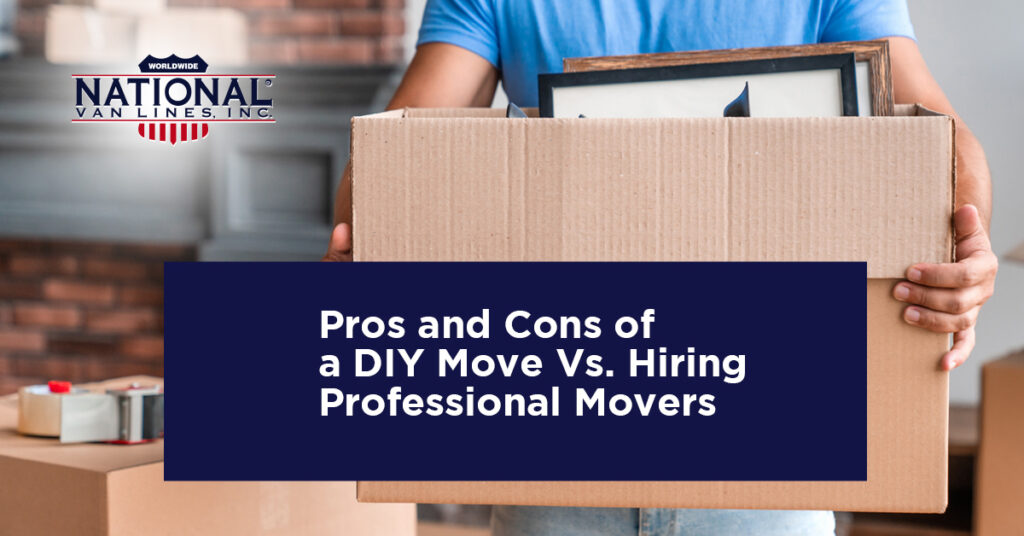
A successful relocation starts long before moving day, with your plans for packing and moving setting a solid foundation. In the weeks and months before the relocation, taking the time to find a mover in your state and begin preparations will make all the difference. An early start will give you enough time to declutter, gather your possessions and complete the small details that contribute to a hassle-free move. With that in mind, we have some top recommendations to help your relocation go smoothly.
50 Practical Ideas to Make Packing and Moving Easier
When you’re feeling overwhelmed by everything that goes into a move, it can be helpful to focus on the steps that matter most. You can start by going through our top moving tips and completing several each day.
Tip #1. Have rugs and draperies cleaned prior to moving and leave them in the protective wrapping. Many cleaners will provide drapery removal service as well as pickup and delivery.
Tip #2. Use colored file folder labels or stickers as a quick way to separate the items to be shipped from those that are not going or items going into storage. Mark cartons clearly.
Tip #3. Always mark cartons on the side – not the top. Remember, boxes will be stacked, and you cannot see the contents or room location if the label is on the top of the carton.
Tip #4. “Seam Seal” your boxes by running a strip of packing tape along each of the side seams on the top and bottom of the box, as well as in the center of the flaps. It makes the carton stronger.
Tip #5. Whenever possible, pack electronics in their original cartons. Make certain to use the formed Styrofoam. Record the model and serial number on the outside of the carton. To make installation easier at your new home, color-code cables and connectors with stick-on labels. A digital photograph of the connections may also be helpful.
Tip #6. Use Ziploc bags to pack like-items in desk drawers. As long as the bags are not very heavy, you can replace the items in the drawer if you have sealed the bag with enough air cushion to protect the contents. The air cushion will secure the bag from moving around in the drawer.
Tip #7. Give your propane tanks to the new owners or one of your neighbors. They can always use a spare, and the cost of having a propane tank purged for safe transport is more than the cost to replace it.
Tip #8. Keep an envelope for your receipts – moving expenses can be tax deductible if your move is job-related. Check IRS Publication 521.
Tip #9. Before the move, seek out special activities to do in your new city with your kids. Set a date, and give them something to look forward to.
Tip #10. Take advantage of spare suitcases. They can be packed with soft goods, but remember to label them just like you would a carton. Simple moving preparation tips like this can help to reduce stress.
Tip #11. Be mindful of a pet’s curiosity. During the commotion of a move, doors will be propped open and boxes can become hiding places. Make arrangements to have your pets in a safe place.
Tip #12. On loading day, before the movers leave, walk through all rooms and look in all cupboards, closets and storage areas one last time. You may have removed everything, but some other family member may have “tucked” something away without your knowledge. Give it one more look to be on the safe side.
Tip #13. Are any of your belongings stored somewhere else? Has the neighbor borrowed your ladder? Are there items in your children’s school lockers? Do you have dry cleaning to pick up?
Tip #14. Eliminate stressful situations whenever you can. For example, don’t try to schedule a flight or a farewell party on the day of the move. Careful furniture handling is the cornerstone of a damage-free move. You don’t want to rush movers because you are racing to catch a flight or going to an event.
Tip #15. If you’re doing your own packing – give yourself plenty of time. Start early by packing seasonal and seldom-used items. Not only will starting to pack early reduce stress, it will eliminate clutter, and even help in the home sale.
Tip #16. Create a “Load Last – Unload First” carton for each family member. That way, everyone can separate the essentials they will need until the last minute and the things they will want the minute they arrive at your new home. Children will find this especially comforting.
Tip #17. Give yourself a break. Consider having a cleaning service come to do the final cleaning on the old home.
Tip #18. Ask a trusted friend or neighbor to assist in watching the children on moving day. You cannot be in two places at once, and on a moving day, your attention will be divided.
Tip #19. Encourage your children to create a “memory book” to remind them of their old home. Include pictures of friends, schools, teachers, favorite restaurants, or “fun places to visit.” Add special touches like aerial views of the neighborhood, menus, church bulletins and local souvenirs.
Tip #20. Plants don’t travel well, but they make lovely thank you gifts. Consider adding some pretty bows to your houseplants and “gifting” them to special friends, teachers and service people.
Tip #21. Have one common place to keep your lists of “things to do” – a spiral notebook works well. Keep it in an easy-to-access spot, and have all family members use the same book. It will remind the rest of the family of things they may not have thought of, and can even create a little competition to get things done and marked off the list quicker.
Tip #22. Add a little fun. Let the children decorate their boxes and add their own personal touches.
Tip #23. Make donating clothing and other items a special experience. Visit the local Goodwill store or homeless shelter with your family. It can make the donation more personal and meaningful. Children will often part with toys, etc., more easily, if they know that they are going to a good cause.
Tip #24. If you are doing your own packing, consider creative ways to use linens, etc. as packing material. Dishcloths and towels are obviously good to use instead of paper. Socks make create wrapping material, also – especially for small knick-knacks.
Tip #25. Now is the time to go through your bookshelves and decide which books you really want to keep. Books are heavy and when you are moving long-distance, your total charges are based on weight. You can use a colored sticker on the spine of the book to indicate the books you are willing to donate. Invite family and friends to come and take their choice of books. You’ll have less to pack as a result.
Tip #26. Consider hiring a college student to help you clean out the garage or the basement.
Tip #27. Wardrobe cartons are designed to hold hanging clothing. You can place small, lightweight items in the bottom of the carton, but you need to make certain that they are secure and don’t move around. They can dislodge the hanging clothes and result in wrinkling. Pillows are a good choice.
Tip #28. When packing pairs of shoes, make certain to wrap each shoe separately. Shoes can scuff each other if not properly protected.
Tip #29. Organizing and packing are time-consuming. Plan ahead and try to do a little each day. Do one hard task each day.
Tip #30. Hold a garage sale before you start packing.
Tip #31. Confirm with your mover what forms of payment are acceptable. Movers do not accept personal checks.
Tip #32. Make a checklist of all of the places you’ll need to change your address. Make sure you include all of your credit cards, loans, banks and former utility companies in case they need to send you a refund or final bill.
Tip #33. If you want to have your mail forwarded, save a trip to the post office by doing it online.
Tip #34. Get two copies of school transcripts, insurance policies, doctor’s records, bank records and birth certificates so that you’ll have one to give to the appropriate parties and one to keep for your records.
Tip #35. When moving boxes or furniture, always bend at the knees. Never lift with your back.
Tip #36. As a rule of thumb, the heavier the item, the smaller the box.
Tip #37. Pack a travel kit including eyeglasses, contacts, contact solution, a first aid kit, prescriptions and medications.
Tip #38. Help your child research your new neighborhood online. The more he or she knows, the less scary it will be. Either find an online map or help the child draw a map of the area.
Tip #39. If you don’t currently have a personal address book, copy all of the numbers from your cell phone into a new phone book and keep it with you. Cell phones are easy to misplace and you may need to contact friends and family for last minute needs.
Tip #40. Call or visit your new Department of Motor Vehicle’s website. Order a copy of your new state’s “Rules of the Road” book. Also, find out what type of mandatory vehicle insurance laws are in your new state so that you can be prepared.
Tip #41. You may drive with your old driver’s license for 30 days after moving into a new state. Designate a specific time to renew your license within that timeframe.
Tip #42. Some banks are nationwide. Contact your bank to find out if they have branches in your new location.
Tip#43. On an interstate move, it will be your responsibility to check off inventory item numbers as the movers bring your furniture and boxes into your new home. Take that responsibility very seriously – it is proof of delivery.
Tip #44. On the day of delivery, inspect the contents of any boxes that appear to have exterior damage, immediately. If packed items have been damaged, you will need to save the carton and the packing material for the claims adjuster.
Tip #45. Make certain that the moving company and the individual driver have contact phone numbers for you. Include your new work number, if available, or the home phone number of someone who will know how to get in touch with you. Cell phone batteries die, and cell phone service is not consistent. You should also get a contact (or direct) phone number for the driver as well.
Tip #46. Credit card payments have to be processed prior to delivery. Make certain you discuss with the moving company when the actual moving charges will be posted to your credit card.
Tip #47. One of our best moving guide tips involves the time after you move in. You can plan ahead for potential delays in internet service by downloading entertainment for offline access later. Having easy access to your favorite movies, shows and music will keep you entertained in your new home if you’re forced to wait for internet installation.
Tip #48. To make it easier to make the beds in your new home, pack a complete set of bedding for each bed (mattress pad, sheets, pillows and pillowcases, blanket and spread) in its own separate box. Mark the box clearly for the specific room/bed.
Tip #49. Make certain to go through the items you have in a mini-storage facility prior to loading day. You may not have packed those items properly for long-distance moving. And you may want to eliminate some things that haven’t been used for a while.
Tip #50. If you have firearms that need to be transported, talk with your moving counselor. They require special handling. If you have a gun safe, you will need to have the combination or the key on loading day, so that the driver can record the model, caliber and serial number. AMMUNITION CANNOT BE SHIPPED.
Expert Packing and Moving Services for Nationwide Relocations
National Van Lines is a leading provider of long distance moving solutions for homeowners and businesses. We offer a range of moving services including packing and unpacking, loading, transportation and storage. Call 800-323-1962 or request a free moving quote now.
Image Credit – Africa Studio/Shutterstock.com




